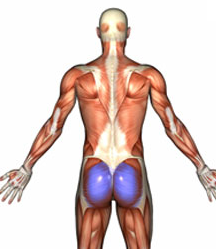The glute maximus is the largest muscle of the gluteal group and arguable the strongest muscle in the body. It inserts into the IT band so it is responsible for hip and trunk extension as well as lateral rotation of the leg and hip. The responsibilities of the glute maximus make it vital in the performance of everyday activities like jumping, standing up from a seated position and bending over. However, present day sedentary lifestyles involve more sitting and less physical activity. Sitting on the glute maximus for extended periods of time keeps the glute maximus under constant tension and pressure. This, over time, causes a shortening of the muscle leading to glute maximus weakness. Weak glute muscles force other muscles in and around the hip complex to work harder. The resulting overcompensation from surrounding muscles increase the risk of injury because these muscles end up doing more than they are supposed to (synergistic dominance).
Due to the interconnected nature of the body, compensations near the site of weakness (the gluteus) can lead to compensations farther away from the site of weakness leading to injuries as part of a “cumulative injury cycle”. Two muscle complexes particularly vulnerable to injury post gluteus maximus weakness are the hamstrings and the adductors. When the glute maximus is weak the hamstrings become overactive trying to control and facilitate the extension and rotation of the leg and hip (especially the biceps femoris/lateral hamstring) leaving them prone to overstretching, strains and tears. The adductors are also at increased risk because they are more heavily recruited during sharp movements in order to try and control pelvic flexion, a job typically done by eccentric activity of the gluteus maximus.
Most sports that incur increased hamstring and adductor (groin) strains typically involve swift motions of the leg and hip as well as sharp changes in speed and direction (ex: football, basketball, soccer). The best way to prevent these injuries is to incorporate stretching and to facilitate proper muscle activation of all the musculature in and around the hip complex. Most people don’t properly train because they don’t know how to spot glute weakness since the body compensates for it so well. The best program to ensure gluteal activation includes unilateral exercises that require hip extension and leg abduction and external rotation (ex: 1 legged dead lift, 1 legged squat, 1 legged step up).
Posts Tagged ‘football’
I’m Baaaaccccckkkk…With More Tips For That Ass…Literally!
Posted: November 15, 2012 by williampower in Behavior Modification, ExerciseTags: adductors, ass, basketball, biceps femoris, butt, corrective exercise, football, glute, glute maximus, gluteal, groin, hamstring, hip complex, IT Band, lateral hamstring, overstretch, pull, soccer, strain, tear, weakness
